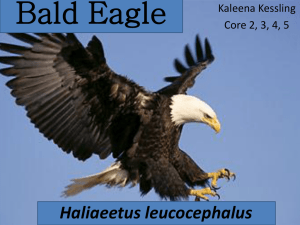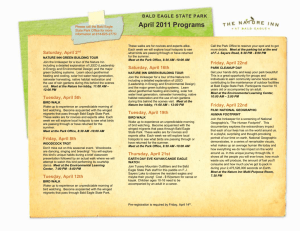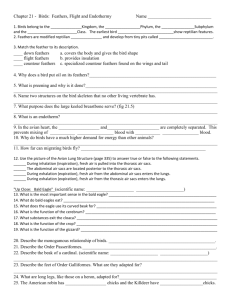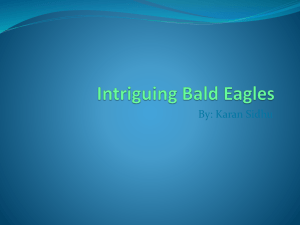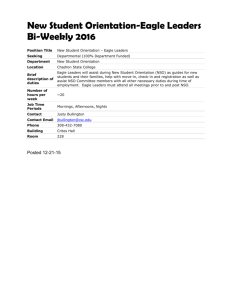Bald Eagle-kindergarten
advertisement
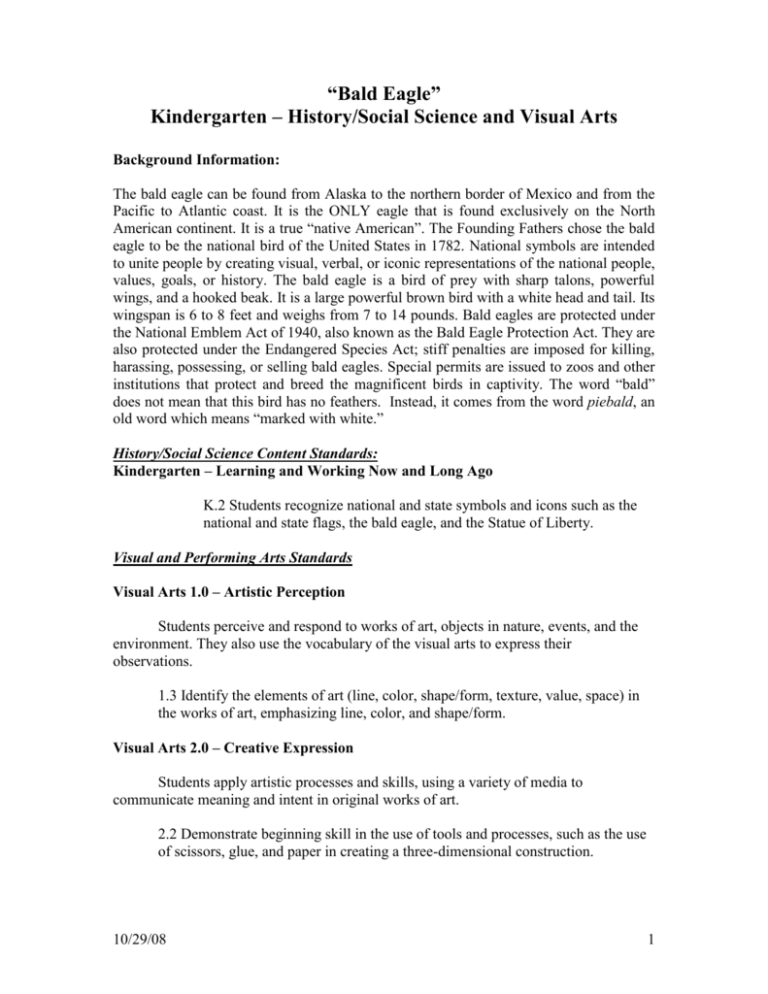
“Bald Eagle” Kindergarten – History/Social Science and Visual Arts Background Information: The bald eagle can be found from Alaska to the northern border of Mexico and from the Pacific to Atlantic coast. It is the ONLY eagle that is found exclusively on the North American continent. It is a true “native American”. The Founding Fathers chose the bald eagle to be the national bird of the United States in 1782. National symbols are intended to unite people by creating visual, verbal, or iconic representations of the national people, values, goals, or history. The bald eagle is a bird of prey with sharp talons, powerful wings, and a hooked beak. It is a large powerful brown bird with a white head and tail. Its wingspan is 6 to 8 feet and weighs from 7 to 14 pounds. Bald eagles are protected under the National Emblem Act of 1940, also known as the Bald Eagle Protection Act. They are also protected under the Endangered Species Act; stiff penalties are imposed for killing, harassing, possessing, or selling bald eagles. Special permits are issued to zoos and other institutions that protect and breed the magnificent birds in captivity. The word “bald” does not mean that this bird has no feathers. Instead, it comes from the word piebald, an old word which means “marked with white.” History/Social Science Content Standards: Kindergarten – Learning and Working Now and Long Ago K.2 Students recognize national and state symbols and icons such as the national and state flags, the bald eagle, and the Statue of Liberty. Visual and Performing Arts Standards Visual Arts 1.0 – Artistic Perception Students perceive and respond to works of art, objects in nature, events, and the environment. They also use the vocabulary of the visual arts to express their observations. 1.3 Identify the elements of art (line, color, shape/form, texture, value, space) in the works of art, emphasizing line, color, and shape/form. Visual Arts 2.0 – Creative Expression Students apply artistic processes and skills, using a variety of media to communicate meaning and intent in original works of art. 2.2 Demonstrate beginning skill in the use of tools and processes, such as the use of scissors, glue, and paper in creating a three-dimensional construction. 10/29/08 1 Visual Arts 4.0 – Aesthetic Valuing Students analyze, assess, and derive meaning from works of art, including their own, according to the elements of art, the principles of design, and aesthetic qualities. 4.1 Discuss their own works of art, using appropriate art vocabulary (e.g., color, shape/form, texture). 4.3 Discuss how and why they made a specific work of art. 4.4 Give reasons why they like a particular work of art they made, using appropriate art vocabulary. Visual Arts 5.0 – Connections, Relationships, Applications Students apply what they learn in the visual arts across subject areas. They develop competencies and creative skills in problem solving, communication, and management of time and resources that contribute to lifelong learning and career skills. They also learn about careers in and related to the visual arts. 5. 3 Point out images (e.g. photographs, paintings, murals, ceramics, sculptures) and symbols found at home, in school, and in the community, including national and state symbols and icons. Learning Objectives: Students will know the art element texture and demonstrate this by using and discussing the word as they talk about their bald eagle artwork. Students will increase their skill of cutting and gluing and demonstrate this with the processes used in creating the bald eagle head. Students will increase their ability to analyze and assess art by discussing their own works of art and using the appropriate terminology. Vocabulary: texture bird of prey United States feathers national power symbol country bald eagle protected law surface Materials: tag board/heavy paper with bald eagle head black line drawing (see lesson plan book) feathers white glue squiggly eyes scissors 10/29/08 2 blue and red construction paper (9 x 12”) yellow or yellow-orange crayons rock, piece of stone, or brick Motivation: Students in kindergarten are introduced to basic spatial, temporal, and causal relationships, emphasizing the geographic and historical connections between the world today and the world long ago. The stories of ordinary and extraordinary people help describe the range and continuity of human experience and introduce the concepts of courage, self-control, justice, heroism, leadership, deliberation, and individual responsibility. Historical empathy for how people lived and worked long ago reinforces the concept of civic behavior: how we interact respectfully with each other, following rules, and respecting the rights of others. Visual Arts Content Lesson: 1. Hold up a sentence strip with the word texture. Ask the students, “Does anyone know what the word texture means?” 2. Have students run their hands across the desk. “How does your desk feel?” (smooth) “Look at this rock/stone/brick, how do you think this feels?” Have students answer and have some students feel the rock/stone/brick. (rough, bumpy, etc.). 3. Describe to students the meaning texture. (Our world is full of a rich variety of surfaces that provide us with both information and visual pleasure. Texture is the physical surface structure of a material.) 4. Have pictures of bald eagle(s) available as reference, or refer to history/social science big book for kindergarten, “Our World, Now and Long Ago”, Unit 2, page 17 and Time for Kids reader, “The Bald Eagle”. “Does the bald eagle have texture? (yes) “What type of texture? Remember the definition of the word texture. (feathers are texture) Have a example of the bald eagle project done so feather texture can be identified and explained. “Today we are going to use texture in making our art project.” Procedure: 1. Introduce the word, texture to students on sentence strip or other display means. 2. Guide students through the process of identifying texture with desks and rock/stone/brick, and discuss meaning. 3. Display pictures or refer to pictures of bald eagle(s). 4. Give each student the “eagle head” handout copied on heavy paper. 10/29/08 3 5. Make sure each student has access to a yellow or yellow-orange crayon. “The first thing I would like you to do is to color the beak of the bald eagle. What color is the beak?” (refer to pictures/big book/time for kids reader) Students should identify yellow/yellow-orange as the color of the beak. 6. After students are finished coloring the beak, have them cut out the bald eagle head. 7. Mount each bald eagle head on blue or red construction paper. (teacher choice or student choice) 8. The next step is to glue on feathers onto the bald eagle head. Give each student a small pile of feathers, explain and demonstrate how to glue. (white or light feathers at the top of the head, dark feathers at the bottom of neck.). Distribute glue. 9. When the feathers are all glued and dried, give one squiggly eye to each student. Have them glue in place in indicated eye area. 10. When artwork is completed ask students about the project, the choices they made and their perception of what they did. Assessment and/or Evaluation: What do we want students to know? Students will know the art element of texture and demonstrate this is class discussion and student evaluation of art project. Students will increase their beginning skill in the use of tools and processes of art and demonstrate this by using scissors and glue. Extensions: 1. Show students national symbols from other countries and ask what they think they represent. . 10/29/08 4

